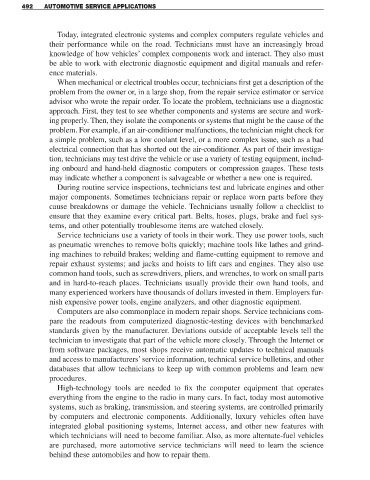Page 514 - Solid Waste Analysis and Minimization a Systems Approach
P. 514
492 AUTOMOTIVE SERVICE APPLICATIONS
Today, integrated electronic systems and complex computers regulate vehicles and
their performance while on the road. Technicians must have an increasingly broad
knowledge of how vehicles’ complex components work and interact. They also must
be able to work with electronic diagnostic equipment and digital manuals and refer-
ence materials.
When mechanical or electrical troubles occur, technicians first get a description of the
problem from the owner or, in a large shop, from the repair service estimator or service
advisor who wrote the repair order. To locate the problem, technicians use a diagnostic
approach. First, they test to see whether components and systems are secure and work-
ing properly. Then, they isolate the components or systems that might be the cause of the
problem. For example, if an air-conditioner malfunctions, the technician might check for
a simple problem, such as a low coolant level, or a more complex issue, such as a bad
electrical connection that has shorted out the air-conditioner. As part of their investiga-
tion, technicians may test drive the vehicle or use a variety of testing equipment, includ-
ing onboard and hand-held diagnostic computers or compression gauges. These tests
may indicate whether a component is salvageable or whether a new one is required.
During routine service inspections, technicians test and lubricate engines and other
major components. Sometimes technicians repair or replace worn parts before they
cause breakdowns or damage the vehicle. Technicians usually follow a checklist to
ensure that they examine every critical part. Belts, hoses, plugs, brake and fuel sys-
tems, and other potentially troublesome items are watched closely.
Service technicians use a variety of tools in their work. They use power tools, such
as pneumatic wrenches to remove bolts quickly; machine tools like lathes and grind-
ing machines to rebuild brakes; welding and flame-cutting equipment to remove and
repair exhaust systems; and jacks and hoists to lift cars and engines. They also use
common hand tools, such as screwdrivers, pliers, and wrenches, to work on small parts
and in hard-to-reach places. Technicians usually provide their own hand tools, and
many experienced workers have thousands of dollars invested in them. Employers fur-
nish expensive power tools, engine analyzers, and other diagnostic equipment.
Computers are also commonplace in modern repair shops. Service technicians com-
pare the readouts from computerized diagnostic-testing devices with benchmarked
standards given by the manufacturer. Deviations outside of acceptable levels tell the
technician to investigate that part of the vehicle more closely. Through the Internet or
from software packages, most shops receive automatic updates to technical manuals
and access to manufacturers’service information, technical service bulletins, and other
databases that allow technicians to keep up with common problems and learn new
procedures.
High-technology tools are needed to fix the computer equipment that operates
everything from the engine to the radio in many cars. In fact, today most automotive
systems, such as braking, transmission, and steering systems, are controlled primarily
by computers and electronic components. Additionally, luxury vehicles often have
integrated global positioning systems, Internet access, and other new features with
which technicians will need to become familiar. Also, as more alternate-fuel vehicles
are purchased, more automotive service technicians will need to learn the science
behind these automobiles and how to repair them.

